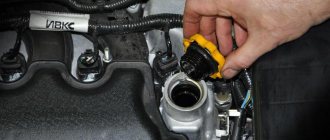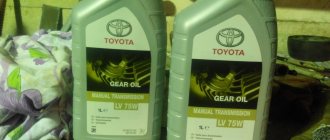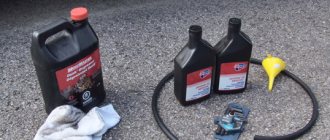Engine oil
Scheduled oil and filter changes are one of the main tasks that a car owner faces. But we don't mean spending money on visiting auto service centers. A planned replacement can be done at home, with your own hands. You need to have a minimum set of tools, rags, new consumables and about an hour of free time.
What kind of oil to pour and how much
For the engines of this car, it is officially recommended to fill in oil with a viscosity class of 5W30, 5W20 for gasoline engines, and 5W30 and 10W30 for diesel engines.
- Mazda Dexelia Ultra 5W30 - original;
- TEXACO HAVOLINE ENERGY 5W30;
- Totachi 5W30;
- Bardahl xtc 5w40;
- Castrol 5w30;
- SHELL HELIX 5W30 ECT;
Refueling volumes:
- 1.8 MZR (L813) - 4.3 l;
- 2.0 MZR (LFF7, LF17, LF18) - 4.3 l;
- 2.0 diesel (RF5C) - 4.1 l;
- 2.3 (L3C1) - 4.4 l;
How to change
- Warm up the engine for about 5 minutes. Cold oil causes poor flow from the engine; as a result, a lot of dirty oil may remain, which you will eventually mix with new oil. This will degrade the performance of the new oil.
- To access the bottom of the car, it would be ideal to have an inspection hole, but in the absence of one, a regular jack with stands will do. Some models may have engine crankcase “protection” installed. It needs to be removed to access the drain plug.
- For a better “drain” of waste fluid from the crankcase, unscrew the filler plug of the neck and you can also pull out the dipstick. The oil drains faster if there is a through hole.
- We substitute a basin or any other container that can hold 5 liters of waste.
- We unscrew the drain plug with a wrench (it is better if the ratchet wakes it up). It is best to immediately expect that the oil will be hot. At this stage of work you need to be most careful.
- After completely draining the old dirty oil, which is black in color, remove the basin to the side.
- An optional item is flushing the engine with a special flushing liquid. You will be surprised at the black oil that comes out with this liquid. This liquid is very easy to use. We fill it into the engine, after tightening the drain plug of course. We start the car for 3-5 minutes. At the same time, we drive and heat our liquid on an old oil filter. Afterwards, we turn it off and pour it into a free container.
- We replace the oil filter with a new one. Before installing the new filter, pour about 100 g of fresh oil into it and also lubricate the rubber O-ring on it.
- Fill in new oil. Having made sure that the drain plug is screwed in and a new oil filter is installed, we can begin to fill in new oil using the dipstick as a guide. The level should be between the minimum and maximum marks. Also, you need to remember that after the first start of the engine, some oil will leave and the level will drop.
- Recheck the oil level using the dipstick after the first start. Let the engine idle for about 10 minutes.
WHEN TO CHANGE OIL IN MAZDA 6 GH
The maintenance regulations for the second generation Mazda 6 (GH) indicate the frequency of changing the engine oil and oil filter: 15, 30, 45, 60, 75, 90, 105, 120, 135, 150, 165, 180 thousand km, then every 15 thousand kilometers, but at least once a year.
In the engine oil change section of the operating manual, it is stated that under heavy operating conditions, in a large city or in a very dusty area, it is recommended to replace the engine oil and oil filter every 10,000 km. Severe operating conditions include long periods of downtime, vehicle overload, driving at significantly higher speeds, off-road driving, regular short-distance driving, and use of vehicles at critically low temperatures. Also, difficult operating conditions include mountainous terrain, long-term driving at low speed, and engine operation at idle speed.
Also read: Engine oil for Mazda 3 BK engine
Oil filter
An important component in the lubrication system of any car. Motor oil lubricates rubbing parts, and the oil filter retains metal debris (crumbs, sawdust, dust, sand and other debris) and in this way cleans this oil.
When should you change the filter?
Each filter must be replaced along with changing the engine oil. They must be considered one mechanism and must also be serviced together. Recommendation for replacement every 10-15 thousand km or once a year.
Required Tools
- 10 and 15 mm wrench. It is better to take a socket with replaceable heads.
- Container for draining waste (dirty engine oil)
- Oil filter puller for size 76 mm and hex wrench for 6 mm.
- New consumables in the form of a filter and sealing rings.
Which filter should you choose?
Different filters are installed for different engine modifications. Below we will give an example of filters that can be installed on specific Mazda 6 engines.
Engine 1.8 (L813, L823, L828)
- PARTS-MALL PBH-034
- PROFIT 1541-0172
- STARLINE SF OF0315
- BLUE PRINT ADM52118
- KNECHT/MAHLE OC 1182
- PURFLUX L340
- JAPANPARTS FO-394S
Engine 2.0 (LF17, LF18)
- CLEAN FILTERS DO 942
- CLEAN FILTERS ML1703
- NIPPARTS J1313023
- DENCKERMANN A210414
- PURFLUX LS357
Motor 2.3 (L3C1)
- JC PREMIUM B13022PR
- JAKOPARTS J1313025
- HENGST E20H D79
- Dello 30103430102
Diesel 2.0 (RF5C)
- PROFIT 1540-0740
- JAKOPARTS J1317003
- MAXGEAR 26-0272
- NIPPARTS J1317003
- ASHIKA 10-05-599
- BOSCH 0 451 103 316
Of course, this list is not the entire line of engines of different generations, but more as an example. If you haven’t found suitable filters for your Mazda 6 engine, write in the comments below, we will select and list inexpensive companies specifically for your car!
Step-by-step oil change process
- Warm up the engine (the temperature should reach operating temperature);
- We turn off the car's power plant and wait about 5 minutes - all the oil from the engine should drain into the sump;
- We install a container for draining the waste;
- Remove the cap from the oil filler neck;
- Now we go down and unscrew the plug from the crankcase (sump) using a ratchet and a suitable socket;
- After the used composition stops expiring, screw it back on;
- We unscrew the plug from the filter housing using a hexagon (some more oil may leak out);
- Using a special device (puller), remove the filter housing block;
- We take out the used filter and install a new one in its place;
- Now the rubber seals should be replaced: one on the side of the drain plug, the other on the side of the filter element housing;
- We insert the block we assembled back and tighten the fixing plug;
- Fill in about five liters of fresh oil;
- Close the oil filler neck;
- We start the engine briefly (so that the oil pressure warning light goes out);
- If necessary, add the missing amount of oil.
The normal oil level should be between the two special marks marked on the dipstick. Do not pour above the maximum. Considering that during operation, a car engine consumes up to 800 ml of lubricant per 1000 kilometers, you should periodically check the oil level and, if necessary, replenish it. As you can see, there is nothing complicated here.
Power steering (power steering)
Power steering helps you turn the steering wheel along with the wheels, while you spend several times less force than a car without a power steering system.
There are marks on the power steering expansion tank by which you can understand whether the fluid level is currently high or, conversely, low and needs to be added. A quick inspection of the power steering system can solve many problems along the way, so look under the hood once a month.
What should you pay attention to?
- Monitoring the power steering fluid (oil) level and its color in the expansion tank;
- Checking the drive belt for the power steering pump;
- General condition of hoses (inspection for cracks, abrasions and chips);
- Hose connection points.
How to change
Changing the power steering fluid (oil) can be done in several ways, including partially changing the fluid and completely changing it. The first method is faster and easier, the second is better.
Partial replacement
Partial replacement of power steering fluid involves pumping fluid out of the power steering expansion tank using a large syringe or bulb. After the tank is completely empty, fill in fresh fluid to the maximum mark. Start the car and turn the steering wheel left/right. After a few minutes, turn off the engine and check the color of the power steering fluid. If it is too dark, repeat the procedure until the desired result.
Complete replacement
To replace the power steering fluid, remove the air duct and the reservoir with power steering fluid. Pour the old liquid from the barrel into another container. When draining, pay attention to the condition of the old oil and the presence of foreign metal particles. If they are noticeable, this may indicate wear on the pump. To completely drain the power steering, you can rotate the steering wheel left and right.
Oil pressure sensor
If the oil pressure sensor lights up on a Volkswagen Polo, then a fascinating set of checks of the engine and individual components awaits you. What could cause the sensor to light up?
- Low level of oil pressure in the engine. The simplest option is to check the dipstick, if you add too little to the required level.
- Oil too old. Look at the color of the oil, rub it with your fingers (you should feel oily). If the oil is too old, it is better to change it to a new one.
- Oil pump malfunction.
- The oil pressure sensor has failed. If you checked the previous steps and nothing helped, check the sensor itself. A visual inspection will help determine the external condition of the device. If necessary, replace with a new one. It happens that the sensor is covered in oil, this may indicate that the leak is coming through the sensor. Of course, such a part must be replaced immediately.
How to replace
Replacing the sensor does not require much effort. At the rear of the cylinder block (where the unit number is indicated), press the wire lock and remove the terminal. The sensor itself is unscrewed with a key x 22. When installing a new sensor, make sure that there is a sealing washer.
Oil selection
Choosing oil is as important a step as buying the car itself. The wrong oil can damage your car's engine. Usually, when a driver comes to an auto parts store, he wonders: how to choose the right oil for his car?
To correctly select and purchase lubricating fluids, the following parameters should be taken into account:
- year of manufacture of the car;
- car mileage;
- date of the last update of lubricants in the engine.
Provide this information to the seller and he will give you the product you need. You can also look at the back of the canister for yourself. The information you are interested in will be indicated there:
- oil composition;
- viscosity.
Based on this data, you can choose the product you need. You should only buy the mixture that matches the performance of your car.
How much to fill (filling volumes)
Data on filling volumes may differ from the data of your car. Exact passport data can be found in the car manual.
- Fuel tank – 64 l (AI 95).
- Cooling system – 1.8/2.0/2.5 – 7.5 l (Coolant FL 22).
- Lubrication system – 1.8/4.3 l, 2.0/4.3 l, 2.5/5.0 l (SAE 5W-30, 10W-40. ACEA A3/A5 quality. You can use original MAZDA Dexelia oil).
- Mechanical transmission - 7.5 l (75W-90, API GL-4, GL-5).
- Automatic transmission – 8.14 l (ATF MW – automatic transmission fluid).
- Windshield washer - 3.6 l.
Spread the love
WHAT OIL SHOULD BE FILLED IN A MAZDA 6 GH
Original
The original oil for Mazda engines is produced by the French company Total. Mazda Original Oil Ultra 5W-30 is one of the original synthetic oils that is suitable for the second generation Mazda 6 (GH). It fully complies with the recommended oil tolerances for engines of this generation. Classes of the oil in question: API SL/CF, SAE 5W-30, ACEA A5/B5. Let's take it in order, API is an abbreviation of the American Petroleum Institute, which introduced its own classification based on the technical compliance of engines of certain years of manufacture. The designations are divided by engine type: (S) – gasoline engines, (C) – diesel engines.
Also read: Engine oil for MAZDA FAMILIA engine
The SL class was introduced in 2001 and provides for the improvement of the antioxidant, detergent and energy-saving properties of oils. Class CF was introduced in 1994 and is also intended for use in SUVs. Both classes can be replaced by more modern classes. SAE is an abbreviation for the Society of Automotive Engineers, which has developed a classification of oils by viscosity, which characterizes the performance properties of oils in accordance with ambient temperature. 5W-30 indicates a temperature range of application from – 30 to + 25 C.
ACEA is an abbreviation for the Association of European Automobile Manufacturers, the designation provides for division by engine type: A - petrol, B - diesel. The figure corresponds to the years of manufacture and technical level of the engines. A5/B5 is intended for use in gasoline and diesel engines of passenger cars with extended replacement intervals.
Analogs
When selecting non-original oils, you must focus on the vehicle engine tolerances. When changing engine oil, it is recommended to flush the lubrication system. As an analogue for the second generation Mazda 6 GH, you can consider:
- MOBIL 1 X1 5W-30 is a synthetic motor oil, API SN class, ACEA class A1/B1, A5/B5 for gasoline or diesel engines. API SN class is more modern than SL/SM - recommended for the GH generation Mazda 6, however, SN class oils are recommended to replace earlier ones.
- Shell Helix HX8 A5B5 5W-30 – synthetic motor oil, API SN class, ACEA A5/B5 for gasoline or diesel engines;
- ELF Evolution 900 SXR 5W30 – synthetic motor oil, API SL class, ACEA A5/B5 for gasoline or diesel engines;
- Idemitsu Zepro 5W30 – synthetic motor oil, API SN class for gasoline engines;
- Motul 8100 eco-lite 5W-30 – synthetic motor oil, API SN class for gasoline engines;
- Total quartz 9000 future nfc 5w-30 - 5W30 - synthetic motor oil, API class SL, ACEA A5/B5 for gasoline or diesel engines.










